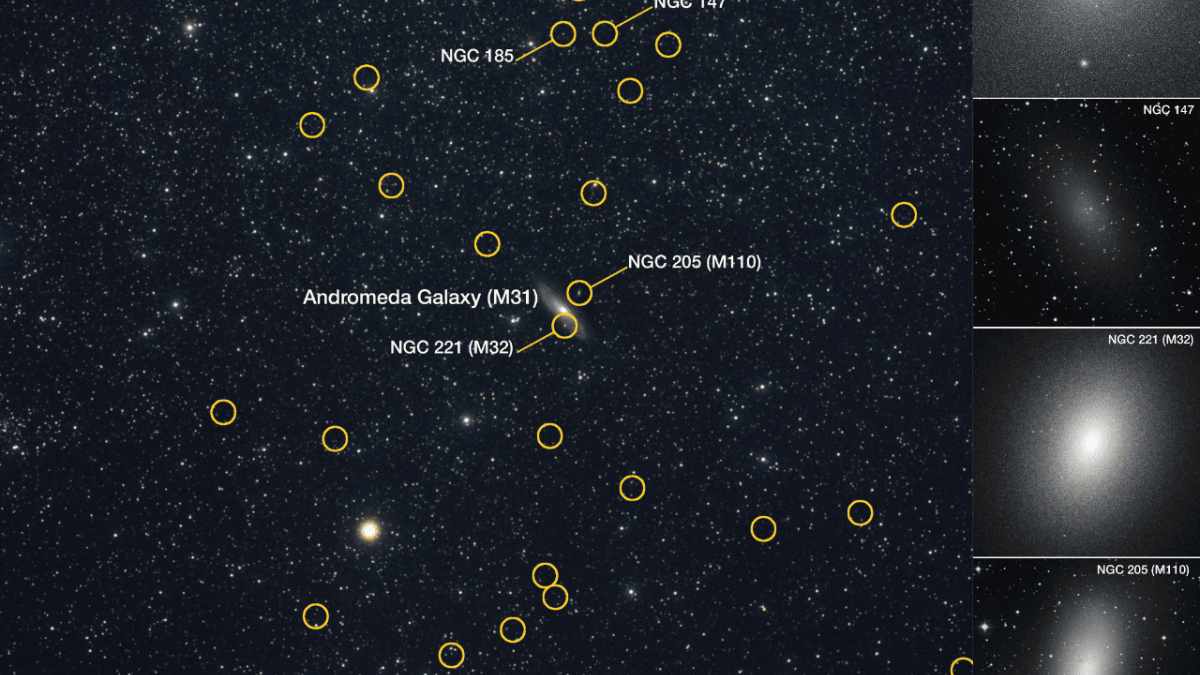University of Surrey joins international study to map Andromeda’s galactic ecosystem
A collaboration of more than 30 international institutions, including the University of Surrey, has observed vast differences in the dynamic ecosystem of smaller satellite galaxies orbiting our neighbour galaxy, Andromeda. Surveyed using images from over 1,000 Hubble Space Telescope orbits, the findings have given scientists new insights into the evolution of galactic systems.

This is a wide-angle view of the distribution of known satellite galaxies orbiting the large Andromeda galaxy (M31), located 2.5 million light-years away. The Hubble Space Telescope was used to study the entire population of 36 mini-galaxies circled in yellow. Andromeda is the bright spindle-shaped object at image center. All the dwarf galaxies seem to be confined to a plane, all orbiting in the same direction. The wide view is from ground-based photography. Hubble's optical stability, clarity, and efficiency made this ambitious survey possible. Hubble close up snapshots of four dwarf galaxies are on image right. The most prominent dwarf galaxy is M32 (NGC 221), a compact ellipsoidal galaxy that might be the remnant core of a larger galaxy that collided with Andromeda a few billion years ago. Credit: NASA, ESA, Alessandro Savino (UC Berkeley), Joseph DePasquale (STScI), Akira Fujii DSS2
The study, published in The Astrophysical Journal, found that Andromeda’s satellite system is notably different from our own Milky Way, 2.5 million lightyears apart. While both galaxies are surrounded by a flotilla of smaller dwarf galaxies, Andromeda likely hosts three times as many – offering a rare glimpse into their unique history and formation.
One of the study’s key themes is how Andromeda’s dwarf galaxies have formed and sustained stars in unexpected ways compared to those around the Milky Way. Researchers had long assumed low-mass galaxies would follow similar patterns, but the Andromeda system tells a different story. These satellite galaxies appear to have experienced a more complex evolutionary history, with some continuing to form stars far longer than anticipated.
Star formation really continued to much later times, which is not at all what you would expect for these dwarf galaxies. This doesn't appear in computer simulations. No one knows what to make of that so far.Dr Alessandro Savino, lead author of the study from the University of California, Berkeley
To explore these differences more closely, researchers at the University of Surrey are working to understand the forces driving these unexpected evolutionary patterns. A follow-up study will investigate the mass profiles and dark matter distribution of Andromeda’s satellite galaxies, integrating data from this paper with new observational measurements.
Combining the latest Hubble data with ongoing studies at Surrey, the team plans to gain a deeper understanding of the mechanisms shaping galaxies across the universe. Additionally, Hubble is providing the first set of images that allows astronomers to measure the motions of Andromeda’s dwarf galaxies – offering a rare opportunity to track their movements and reconstruct their past interactions.
To find out more, visit the Space Telescope Science Institution's news page.
###
Notes to editors
- Dr Michelle Collins is available for interview; please contact mediarelations@surrey.ac.uk
- The full paper is available at https://iopscience.iop.org/article/10.3847/1538-4357/ada24f#apjada24fs6
